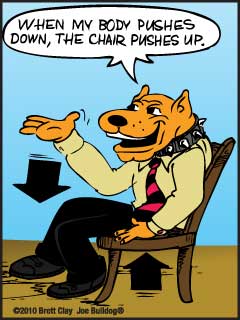Change Leadership — Secret # 28
Every Force Has Equal Resistance
People are more like walls than windows; they’re hard to see into and the harder you push, the harder they push back. —Brett Clay
What I Need to Know |
One of Isaac Newton’s basic principles of physics is the concept of equal and opposite forces. When you are sitting in a chair, right now, you are exerting a downward force on it, which is your mass times the acceleration of gravity. The chair is pushing upward on you with equal force. This concept from physics has interesting implications for the change leader studying a person’s force field.
Does it mean that for every one of a person’s needs, say, safety for example, that there is an equal force pushing back on that need? That is correct. Lewin’s second law states that a force will result in a movement. So, if a force exists (remember that according to Maslow the force can only exist if the need has not been satisfied), but there is no movement, then there must be an equal force pushing back, resisting the movement.
This introduces another important concept described by Lewin: tension. Lewin says these driving forces and equal resisting forces are in tension, which he defines as the sum of the driving and resisting forces associated with a specific change. For example, the tension in the seat of the chair you are sitting on is twice your weight.
As a change leader, one of your most important tasks is to identify the resisting forces that are keeping the person or situation in tension. Each of those forces will have to be removed or overcome to reduce tension and execute change.
What I Need to Do |
For every force you have mapped in the client’s life space, identify an equal force that is opposing it and is restraining change from occurring.
Sometimes restraining forces may be subtle or hidden. If you cannot find an equal and opposite force, then you have to ask, “Why hasn’t this change occurred already? Why does this force exist? Why hasn’t it been satisfied?” The answers will uncover the resisting forces.
Think of several ways each resisting force could be reduced or eliminated.
Resisting forces often take the form of major obstacles, especially when they involve habitual behavior like smoking or eating. In those cases, it may seem easier to increase the driving forces rather than reduce the resisting forces. That may be true. But reducing resistance is always more effective. Less resistance requires less force to overcome it, requiring less effort to make the change and less effort to maintain the change (e.g., weight loss).
Action Summary |
|
 |



Social